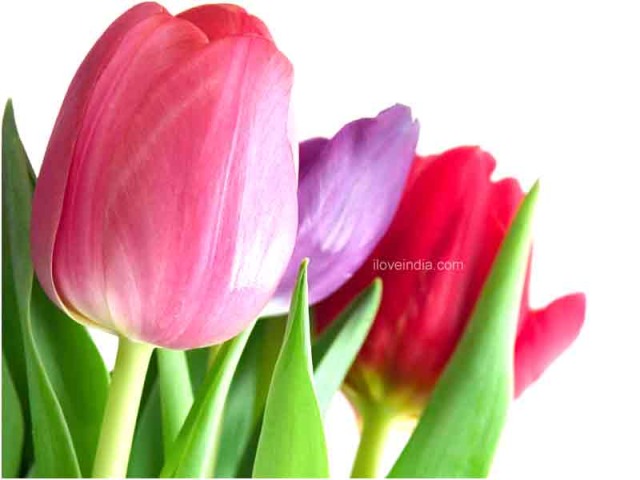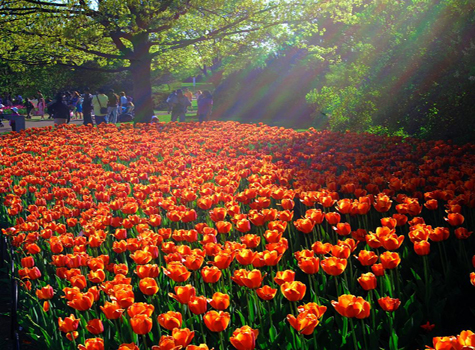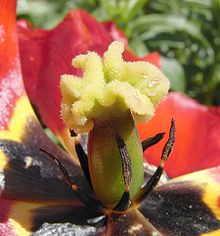Friday, October 28, 2011
Dutch Tulips



The beginning of the cultivation of flower bulbs for the purposes of commerce was 400 years ago in Haarlem and nearby areas. 'De bollenstreek' or the bulb district, lays between Haarlem and Leiden, with a large percentage of the population earning their living from bulbs in the forms of nurseries, industries that supply the sector or in exporting the flowers. The center of the bulb-growing area was the town of Lisse, where there is still held a famous flower exhibition called 'de Keukenhof'.
Tulip ownership became a major status symbol among middle and upper class Dutch families by the early 1630s. Lower classes traded bulbs at local taverns to meet the skyrocketing demand. They sold tulips simply to make money. Single bulbs fetched exorbitant prices. The tulip craze got out of control by 1636; buyers started exchanging huge amounts of cash and goods to obtain a single bulb.
February 1637 heralded the dramatic crash of the Dutch tulip market and a major crisis followed. Prices had soared to such high levels that the smaller tulip buyers and traders found it hard to purchase bulbs. Gradually, the prices rose so high that many buyers either could not or did not want to purchase them, leading to a 90% crash in tulip bulbs. Tulip traders and buyers found themselves in a financial dilemma, and the Dutch courts refused to honor tulip contracts. All contracts created before November 1636 were declared null and void by the Amsterdam authorities.
No species of tulip is native to Holland, although it is usually associated with these stunning flowers that are today available at reasonable prices. Flowers bulbs in the Netherlands are a source of pride and passion as well as a product.
Thursday, October 27, 2011
Water Fountain Garden

Water Fountain Garden
Water Fountain Garden

Water Fountain Garden
Water Fountain Garden
A garden of water-Fontana will go wherever nell’ iarda on the patio a balcony or in a porch and even all’ inside. But determined characteristic dell’ water is adapted more best that seen determined others to (and the sure giardinieri for that matter).
What is feasible for l’ installation of the garden of Water-Fontana?
This would have to be your before question and to discover that dressed of the garden of water-Fontana better you your resources and your space you’ necessity of the ll to instruct itself. Or a ” it knows all” before that begun and very you will be prepared to begin your garden dell’ water.
It verifies the prices and it calculates what your estimate can tolerate. It calls the suppliers of the garden who deal the water Fontanas and make the questions with regard to their products. Moreover visits the local water Fontanas. It communicates with the owners or those who take care themselves of they. Local of call the randello-much community has organizations that sponsor the turns. If you’ well informed king you’ ll ago the best programs find l’ easier and impedice installation the frustrations down the road.
Format and

Water Fountain Garden
Water Fountain Garden

Water Fountain Garden
place for the planning of the garden of water Fontana
In the first instance it verifies your place. A great garden of water-Fontana with a spectacular cascade will overwhelm a small lottery. Also it could overwork your estimate your time and your posterior part. A small pond of the garden on one side has been able to obtain lost in an expansive landscape.
If you’ the king planning some thing more has been involved that a garden pre-fact of water-Fontana of the container or Fontana you’ the ll moreover he must control with the offices of county or the city in order to discover if there are of the decrees that are applied all’ installation of the garden of water-Fontana.
Be is calculating when they plan your garden of water Fontana
Calculations in advance payment all the costs. The little ones garden are economic but large the garden can cost thousands of dollars. You don’ the t it wants to be found in the position of giardiniere upgrades them dell’ water that has dug a great hole fine a week of the motivating force in order to only still fill up it because the lining was too much expensive and didn’ t measure in the estimate.
You can need contracting to a great plan (or the parts of it) to a professional. The concrete of deposit installing the power lines masonry job and digging can be immense (and expensive) and is more well intense activities left to for. The majority of the water Fontanas can be bought in easy to install equips.
Currencies your time and resistance. A garden of the bathtub will take un’ now or two for one but a great garden of water Fontana can demand the weeks in order to dig and to construct. Moreover it will demand lle good posterior and strong crews and the piedini. The 18 inch-deep ones 6 feet from a hole from the 4 feet cannot play like a great job but probably it would take to a man of average age of medium resistance an average day the vangata one. For the great plans you can rent a Navy excavator to cucchiaia cuff.
Maintenance of your garden of Water-Fontana
Memories to calculate the time of maintenance also a garden of the bathtub with a giglio of water demands some minuteren hardly a week. Thus ago a garden of the independent wall or of water of Fontana. He adds the plants and the fish and you add more time. A garden hardly some feet through with some plants and fish will have need of your attention for un’ now or less every week. The largest garden can demand two or three hours a week.
YOU WOULD HAVE TO RENT THEM? ABILITIES THAT ARE ALIGNED.
or that it works with the masses and cliffs of medium dimensions 1 – 3 feet of diameter
or that it constructs to a garden wood-parteggiato dell’ water
TO DEFY
or that it installs wall Fontana
or that it installs a ponticello
or that it more works with the great masses and cliffs than 3 feet than diameter
FOR THE PROFESSIONALS (OR HIGHLY – IN EXPERT AMATEURS)
connections of or and l’ other job electrical worker
or that ago to work a Navy excavator to cucchiaia cuff
or that it places fire-brick and block in concrete
or that it installs 1 foot or the highest walls than stone
concrete of deposit of or
ENOUGH EASY FOR THE PRINCIPIANTI
or that it seals and that installs a pump in a container
or that it digs a hole some feet through
or that it places flagstone or that collects into a pile the concrete paving blocks
or that it installs the tight widths of the flexible or preformata lining
or that it generates a garden of the swamp
or that it works with the sand the gravel and the masses less than 1 foot than diameter
INTERMEDIATE ABILITIES
or that it installs independent Fontana
or that it constructs to a flow or a cascade
or that it places a patio of the fire-brick
or that it places the small tile amounts

Water Fountain Garden
Water Fountain Garden

Water Fountain Garden
Water Fountain Garden
Relate Tag : Water Fountain Garden,Bamboo Water Fountain Garden,Garden Water Fountain Suppliers,Indoor Water Fountain,Water Fountain Manufacturers
Possibly Related Posts:
Incoming search terms:
- garden water fountains
- garden fountain design
- landscape fountain design
- water fountain garden
- outdoor fountain pictures
- pictures of water fountains
- water fountain in garden
- garden fountain designs
- waterfountain
- landscape fountain
Elements of a Roman-Style Pleasure Garden
There is a considerable body of evidence surrounding the gardens of ancient Rome that details the various elements that comprised their pleasure and villa style gardens. Many classical features are found in today's gardens and landscapes paying homage to those ancient stylized Roman gardens. The following article discusses ways you can transform your garden or landscape into an ancient Roman pleasure garden filled with elements reminiscent of that glorious past.

roman garden fountain
While inhabitants of the city of Rome frequently employed courtyard ( as above) and kitchen gardens, it was the inhabitants of the Roman countryside who perfected the pleasure garden that ancient Roman villas are noted for. These gardens were so beautiful that even the ancient Barbarians who conquered Rome kept them up and learned from their design. Today, gardeners opt for many various themes when designing their own garden or landscape; a roman style garden, because it is classical, will never go out of style and many elements that are reminiscent (mainly reproductions) of the era can easily be found online or at local garden centers.
The overlying ideal of the pleasure garden was for relaxation and rejuvenation. Entertainment was also at the core of the design. The owners of these elaborate villas usually entertained guests and the garden was the ideal place to entertain them. Certainly, the orchards and vineyards were productive and useful to provide the banquets with an abundance of fruits, vegetables and wine. Nevertheless, the idea of the pleasure garden was to showcase the landscape with many beautiful features and breathtaking views.
Most Roman villas featured a transition element between the house and the garden. The Romans incorporated marble into their patio type structures. One can well imagine pergola style overhangs decorated with vines and hanging flowers. Marble was the construction material of choice. Of course, the price of marble is very rich today, so many landscape designers might even consider a painted patio with a marble effect; however, simple large clay tiles like terra cotta work perfectly. Roman style patios would have featured wall art—large frescos depicting scenes from Roman agricultural life. (Visit our section on frescos here: Italian Fresco)
There most likely would have been a dining area—low tables with low couches. Garden furniture is widely available today so purchasers have a good selection. However, to find something in a truly authentic Roman style might warrant a custom job when it comes to furniture. Nevertheless, always opt for lavishly comfortable styles when selecting furniture for your own pleasure garden. Other patio features would include stone planters, a water feature like a chalice well, basin or wall fountain.
 While there is not a wealth of information surrounding the ancient Roman pleasure gardens, there is enough information to suggest that the patio opened up to a grand landscape that was designed in all directions. A walk would be the main element of the grounds for seeing each garden delight. Generally, the property would feature a terraced section, an orchard or vineyard (probably both), a kitchen garden for herbs and vegetables (this might not be a part of the grand garden tour however) and various sections that might contain prized plants like roses. The center of the garden would also feature a special element like a fountain. Other important features might include shrines and grottoes.
While there is not a wealth of information surrounding the ancient Roman pleasure gardens, there is enough information to suggest that the patio opened up to a grand landscape that was designed in all directions. A walk would be the main element of the grounds for seeing each garden delight. Generally, the property would feature a terraced section, an orchard or vineyard (probably both), a kitchen garden for herbs and vegetables (this might not be a part of the grand garden tour however) and various sections that might contain prized plants like roses. The center of the garden would also feature a special element like a fountain. Other important features might include shrines and grottoes.
Water was prized in all styles of Roman gardens—the ancient Romans who were the aqueduct builders of the old world. A Roman pleasure garden would boast several water features on the property. In fact, each view might contain its own water feature. From the central fountain to a stream running down the terrace, to a garden pond to an elaborate pool that was an important social element of the Roman world. When considering water features for your landscape, work with the land, but also with a view for the types of entertaining you will do.
 As for the types of plants, you will certainly want to adapt plant life to your climate but some typical Roman choices would include roses, cypress, rosemary, mulberry and fig trees, dwarf variety trees, tall trees, marigolds, hyacinths, narcissi, violets, saffron, cassia, thyme, and many more. Your pleasure garden should be well-kept and each section should feature its own scheme of plantings. Flowerbeds, groves and water-loving plants should all be included.
As for the types of plants, you will certainly want to adapt plant life to your climate but some typical Roman choices would include roses, cypress, rosemary, mulberry and fig trees, dwarf variety trees, tall trees, marigolds, hyacinths, narcissi, violets, saffron, cassia, thyme, and many more. Your pleasure garden should be well-kept and each section should feature its own scheme of plantings. Flowerbeds, groves and water-loving plants should all be included.
Finally, your ornamentation will go a long way to capturing that ancient Roman feel. Your garden walk might contain hidden arbors with stone benches, various classical figures carved in stone, and perhaps even ruins like a column base implanted somewhere in the landscape. Finally, birds were welcome attractions for the guests of these ancient villas, so consider features that might attract various kinds of wildlife such as birds and other desired animals. ( Above the remains of the 2000 year old Villa Adriana at Night - ANSA)
Garden Fountains
 For a dramatic focal point, a fountain containing elements of art or sculpture may be used; such a piece may be constructed of metal, decorative tile, or a host of other materials limited only to the artist's imagination. Statuary can range from the traditional — a maiden pouring water from a jug, for example — to the whimsical — such as an oversized fish spitting water from its mouth. Ground-level fountains with pedestal bases and wall-mounted fountains are more traditional; they may be found in neat, colonial-style gardens or elaborate Victorian gardens filled with trellises, benches, and statues. In tight spaces, a wall-mounted fountain can provide plenty of impact without stealing precious square footage.
For a dramatic focal point, a fountain containing elements of art or sculpture may be used; such a piece may be constructed of metal, decorative tile, or a host of other materials limited only to the artist's imagination. Statuary can range from the traditional — a maiden pouring water from a jug, for example — to the whimsical — such as an oversized fish spitting water from its mouth. Ground-level fountains with pedestal bases and wall-mounted fountains are more traditional; they may be found in neat, colonial-style gardens or elaborate Victorian gardens filled with trellises, benches, and statues. In tight spaces, a wall-mounted fountain can provide plenty of impact without stealing precious square footage.





















